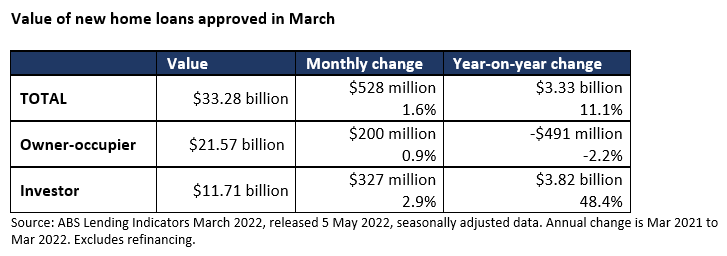- Home
- Home Loans
- News
- Fixed rate home loans slide in popularity as interest rates rise
Fixed rate home loans slide in popularity as interest rates rise

With fixed rates rising rapidly, the number of borrowers choosing to fix their home loans has taken a nose-dive.
The latest ABS lending indicators released this month show the proportion of fixed loans funded in the month of March was just 22 per cent; down from the peak in July 2021 where 46 per cent of all new loans were fixed.

Source: ABS Lending Indicators March 2022, released 5 May 2022, seasonally adjusted data.
Some fixed rate home loan rates have doubled in the last year
Analysis from RateCity.com.au show fixed loan interest rates have risen sharply in the last year and with the average big four bank owner-occupier 2-, 3- and 4- year fixed rates more than doubling.
For example, the average big four bank 3-year owner-occupier rate has risen by 2.31 percentage points compared to this time last year.

The total value of new home lending rises in March, but only slightly
The overall value of new home loans has seen a moderate rise in March according to the March ABS data.
Owner-occupier lending rose by just 1.6 per cent from the previous month, in seasonally adjusted terms.
Meanwhile, investor lending has risen by 2.9 per cent and is up 48.4 per cent from March last year.

The number of first home buyers rises in March
The number of owner-occupier first home buyer loans increased by 4.2 per cent month-on-month in March.
However, year-on-year, the numbers have dropped by 33 per cent, with 5,074 fewer first home buyers in March 2022 than March 2021.

Average national mortgage size now $88K higher than a year ago
The national average new loan size for owner-occupier dwellings is now almost $600,000.
Compared to March last year, that’s an increase of $88,312, or 17 per cent.
In NSW, the average new mortgage size has risen by a whopping $128,842 compared to March 2021, while in Victoria it has gone up by $89,853.
However, with property prices expected to drop in the coming months, it is likely the average new loan size will also come down.

Compare home loans in Australia
Product database updated 25 Apr, 2024
Get updates on the latest financial news and products
By continuing, you agree to the RateCity Privacy Policy, Terms of Use and Disclaimer.



